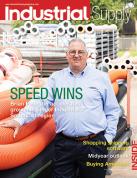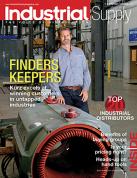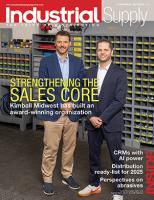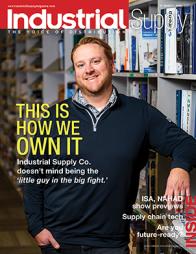High-tech warehouse

by Dick Friedman
New high-tech warehouse technologies may help reduce reliance on not-so-qualified and scarce-to-find warehouse workers, increase warehouse accuracy, productivity and reduce injuries. Furthermore, some new technologies can be linked to older, seldom-used technologies, enabling the older ones to finally become helpful and widely adopted. High-tech might especially help distributors utilizing e-commerce or otherwise picking more single-product orders with a pick quantity of one, but should not be considered until warehouse accuracy and productivity are at high levels.
New Life for Older Technologies
Radio Frequency Identification (RFID) refers to a computer chip affixed to a carton, pallet wrap or a piece. Special readers read stored data such as date of manufacture even if a chip is not in the line of sight, or is hidden by a carton or piece. Using RFID can reduce the time for many warehouse activities and might increase accuracy. However, the cost per chip is still prohibitive for the vast majority of distributors. But new technologies may justify the cost of chips and special data write/read devices.
The Internet of Things (IoT) refers to assigning a unique internet address (IP address) to a device that acquires or transmits data (think of a special light bulb or dedicated sensor), or controls something such as power to an automated conveyor belt. IoT-enabled devices can be programmed and controlled via the internet and might save time and increase accuracy. These devices are just being adapted for warehouse use, because they now can be connected to new technologies that utilize IoT, thereby resulting in the connected warehouse.
Automated Guided Vehicles (AGVs) are forklifts and other types of wheeled, powered product-moving machines. AGVs can increase put-away, replenishment and picking productivity. Until recently, they were controlled by signals that special warehouse software transmitted to wires buried in a warehouse floor. The wires transmitted them to a specific AGV. Burying wires is an expensive process and buried wires cannot be relocated as product-mix, volumes and storage arrangements change. Now, with IoT and other technologies, wires are no longer needed, so remote-controlled forklifts are termed autonomous forklifts.
An Automated Storage and Retrieval System (ASRS) consists of storage units (such as shelves) and an attached software-controlled powered mechanism that puts product into a storage space and picks product from a space. Product is loaded onto or taken from the movable mechanism by people. But newer ASRS versions can be wirelessly interconnected to a single-arm robot that automatically loads or takes product from the mechanism. A robot arm either transfers it to a mobile transport such as a four-wheel cart or a conveyor, or places it in a tote or carton. The process is totally people-less. The combination can save a lot of people time.
High-tech Devices
Even without ASRS, a single-arm robot can be attached to a vertical shaft on a shelving unit and — without any human help — move up, down and over to pick products and place them in totes or cartons on powered conveyor belts. Software determines each pick location, so if storage locations change, the arm is still directed to the proper picking location.
Mobile robots widely used by Amazon and other companies can slide under portable shelving units filled with picked product and move the shelving to sorting/staging/packing areas where people make the final decisions. Similarly, these robots can move received product to put-away locations. These robots are another way to save time. In an effort to advance the use of not-cheap robots, at least one manufacturer now rents them, because robots are viewed as having the greatest potential to increase productivity of any new warehouse technology.
Several companies are experimenting with drones to move small, lightweight products from delivery trucks to customers’ facilities. This is known as the last mile challenge. Drones are already being used by some companies in warehouses and storage yards for cycle counting and other inventory-monitoring activities. Some companies are experimenting with using drones to pick products and take them to a sorting/staging/packing area. A human, not software, controls each drone, which clearly can reduce picking time.
Image-based bar code readers allow reading a bar code no matter the direction in which a code is scanned. The readers scan two-dimensional bar codes, which have been around for a while, and contain much more information than traditional bar codes. These expensive devices increase accuracy and may increase productivity.
Virtual Reality or Augmented Reality headsets display an image of the exact product or carton of products that is to be picked, thereby enabling hands-free picking. This truly high-tech but experimental device saves time, but requires devices to capture the displayed images, which adds to the cost. It competes with Voice Directed Picking (VDP), a well-established technology.
Although high-tech devices may seem too new to be helpful now, a strategic-thinking distributor should monitor their evolving use in the industry to ensure that the foundation of automation, accuracy and productivity are very high – or high-tech may not help.
 For more than 40 years, Dick Friedman has been helping fastener, tool, industrial and MRO distributors prevent inventory shortages and warehouse mistakes that lose sales and customers; and helping them select ERP, e-commerce and WMS systems, while avoiding the problems and pitfalls. Dick does not sell systems, software or warehouse technology. He is a certified management consultant and is objective and unbiased. Reach him at (847) 256-1410 for a free consultation, or visit www.GenBusCon.com for more information or to send email.
For more than 40 years, Dick Friedman has been helping fastener, tool, industrial and MRO distributors prevent inventory shortages and warehouse mistakes that lose sales and customers; and helping them select ERP, e-commerce and WMS systems, while avoiding the problems and pitfalls. Dick does not sell systems, software or warehouse technology. He is a certified management consultant and is objective and unbiased. Reach him at (847) 256-1410 for a free consultation, or visit www.GenBusCon.com for more information or to send email.
This article originally appeared in the March/April 2018 issue of Industrial Supply magazine. Copyright 2018, Direct Business Media.











